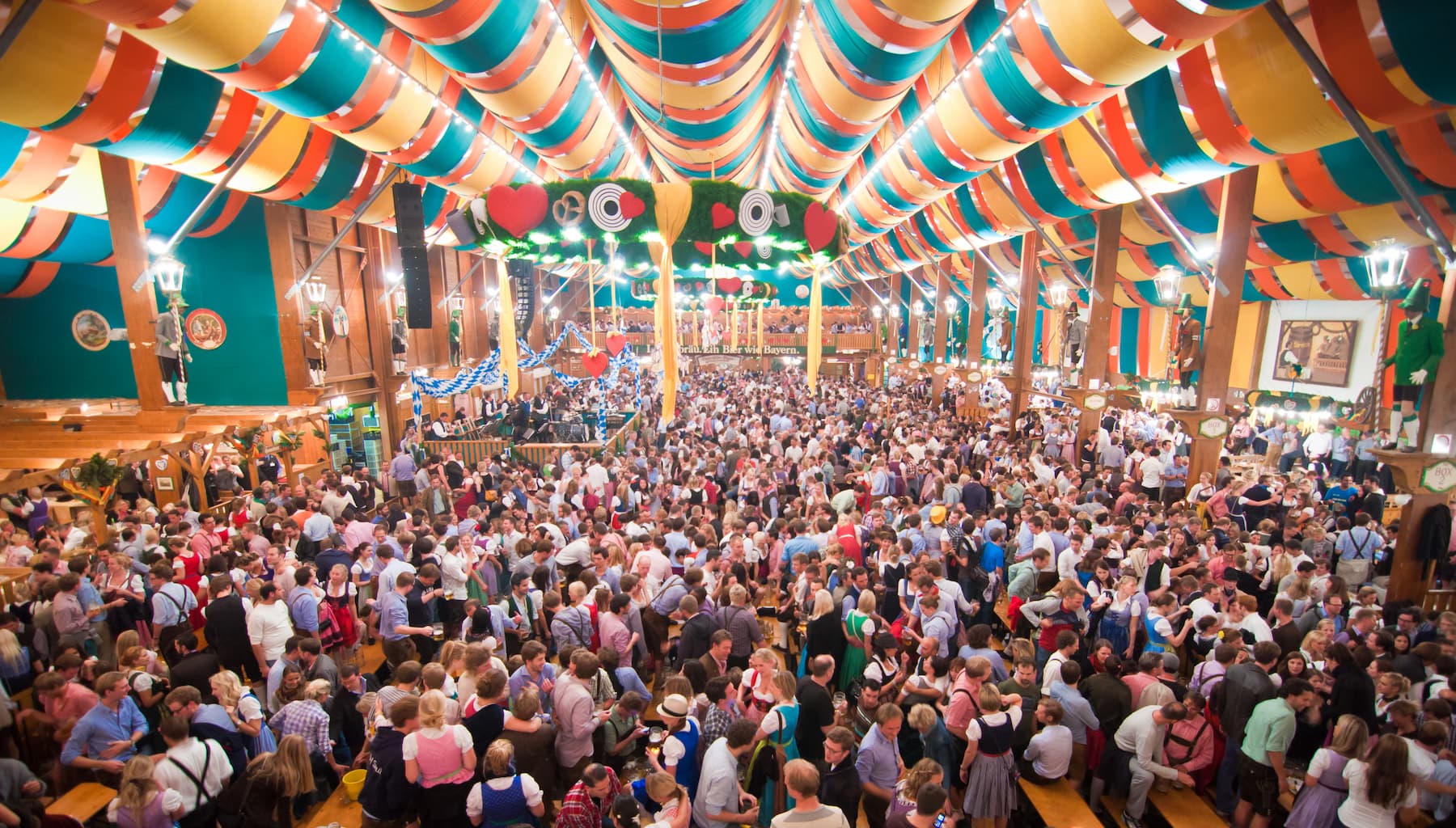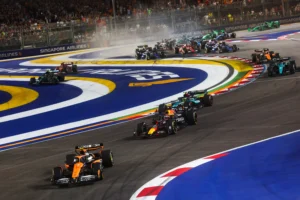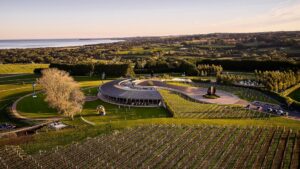Unless you’ve been before, it’s difficult to grasp the size and scale of the official Oktoberfest celebration that occurs each year in Munich, Germany. Regardless, I’m going to do my best to provide somewhat of an overview of the epic event based on my time there last year, distilled as this first-timer’s survival guide to Oktoberfest.
You’ve heard of Oktoberfest before. You know it’s big. You know there’s a lot of beer. You know there’s non-stop singing with just about every nationality from around the world linking arms, standing on tables, while swaying their litre of grog from side to side. It’s a boozy United Nations and one of the best damn times you can have with good beer, good mates, and a whole heap of people down for a good time.
But there are a few things only those who have been before would know about the festival, which in 2023 runs from Saturday, September 16th to Tuesday, October 3rd. The most important, of course, is getting across the many different tents that are peppered around Theresienwiese for the occasion.
Theresienwiese, by the way, is a large open space in Munich located in the borough of Ludwigsvorstadt-Isarvorstadt. It’s the traditional grounds of the Munich Oktoberfest, but also hosts many of the city’s most important events year-round.
If you’re heading to Munich’s biggest cultural event for the first time, I advise you to take a few minutes and read through our guide to Oktoberfest. You’ll especially want to pay attention to the different Bavarian beer tents of Oktoberfest so you’ve got a bit of a roadmap on the day and you don’t waste any time trying to navigate the crowds.
Oktoberfest Survival Guide – Table Of Contents
What Is Oktoberfest?
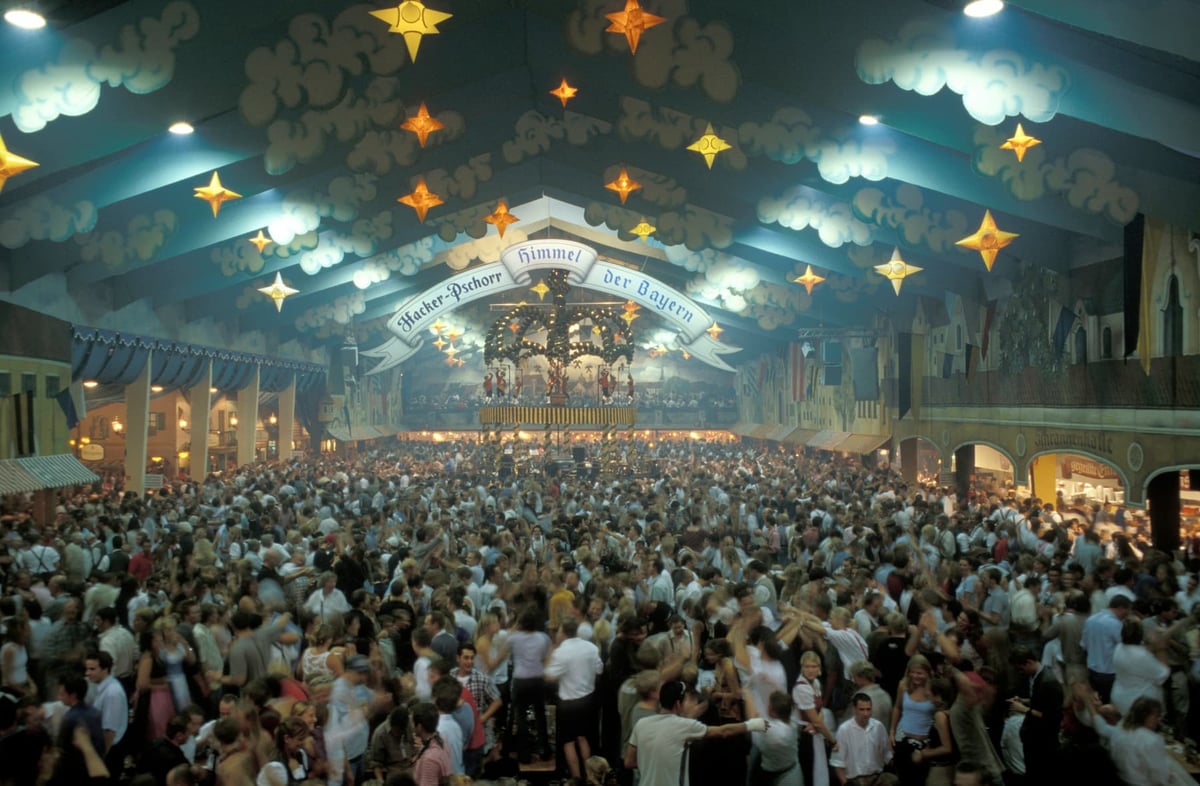
The origins of Oktoberfest date back to October 12th, 1810 when an event was thrown to commemorate the wedding celebration of Bavaria’s Crown Prince Ludwig and Princess Therese of Saxony-Hildburghausen. Think of it as a massive, multi-day medieval soiree with days upon days of drinking, feasting, and horse racing not dissimilar to what you’d see in a show like Game of Thrones.
Most of the festivities were held on the fields just outside of Munich, Germany and the entire event became so popular that it turned into an annual tradition. By the end of the 19th century, this popular celebration then became known as the carnivalesque Oktoberfest, which in Bavarian is nicknamed the “Wiesen” in reference to its traditional location — as mentioned above, Theresienwiese.
It has since evolved to become the world’s largest celebration of its kind, lasting between 16 and 18 days running from late September and always wrapping up on the first weekend in October.
An estimated seven million people from all corners of the world fly into Munich each year to attend a day or two of Oktoberfest (no one attends all 16 days) giving it a very multicultural feel anchored by the throughline of Bavarian traditions. Some crudely refer to it as a drinking festival, and it is very much treated as such, but there’s a multifaceted tradition that sits behind Oktoberfest and holds a lot of meaning for locals.
Nowadays, Oktoberfest celebrations can be found all over the world, although none are as ambitious as the original main event in Munich.
What To Expect From Oktoberfest
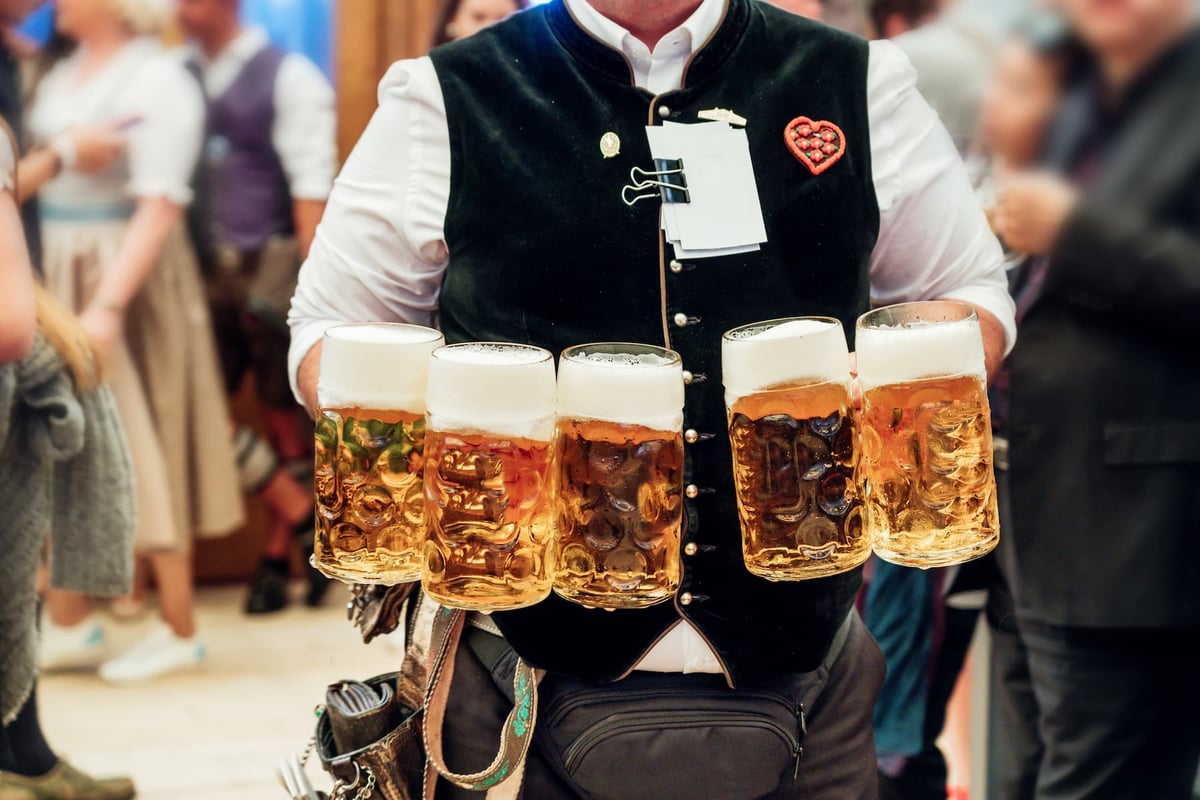
If you’re heading along to Oktoberfest today, you may get the impression that locals have grown to despise the tradition due to the sheer amount of tourists it attracted year in, year out. You’d be wrong.
While you’ll of course get a degree of cynicism from people who’ve been each year and no longer see its appeal, you’ll also — hopefully — notice that Munich Oktoberfest has managed to retain its quintessential Bavarian character while resisting excessive commercialism. This is what has kept the charm in Oktoberfest and made it something worth travelling for.
That isn’t to say the prices don’t reflect commercialism, however. Expect overpriced beers and average, excessively salty food. Yes, that’s a bit harsh but consider that the event has to cater to millions of people each year. Anything mass-produced is going to be lacking when it comes to smaller details.
This is all about the larger-than-life spectacle of Oktoberfest — millions of people standing on tables in massive tents, sloshing litres of beer and clinking glasses with everyone they see while traditional Bavarian bands shouting “Prost” (“Cheers”) echo through each tent.
There are a few constants that are important to Oktoberfest’s identity. Firstly, and probably most importantly, the original six Munich breweries still provide the beer and you’ll see them advertised everywhere. All tents also only allow traditional Bavarian music to be played before 6 PM and you’ll often see both locals and visitors running around in traditional Bavarian dress — leather lederhosen for men, dirndl for women.
Tents are always the same and regulars swear by their favourites. There are also numerous forms of entertainment like Schichtl’s variety show, a carousel dating back to 1924 and a crossbow competition. Needless to say, it’s wild and one of the most intense celebrations in Europe.
You can also expect to hear the song ‘Ein Prosit der Gemütlichkeit‘ played multiple times in every tent. If you don’t know it, you’ll be very familiar with it by the end of the day and most crowds would exit the festival singing this or — unfortunately — ‘Hey Baby’ by DJ Otzi. You’ll recognise the traditional song by the chorus, which sounds like “I’m prosting, I’m prosting.” When you hear it, that means it’s time to clink glasses and take a nice, big swig.
How Much Does Oktoberfest Cost?

While Oktoberfest is free entry, once inside you should expect the type of prices typical of a tourist trap. We’re talking around €12 ($19) for a beer and up to €20 ($31) for a full meal. Do your research if you’re on a budget. Some tents offer lunch specials for as little as €10 ($15) and outside of the tents you’ll find various stands selling simple foods like sausages and wursts for around €5 ($7.50).
If you want guaranteed seating in a tent, and usually prime position, then you’ll want to reserve a table far in advance. This usually happens by emailing the individual tent at the start of the year, given reservations fill up fast. It’ll cost you too. While the reservation is technically free, you’re required to pay for food and drinks per person, and you’ll need to rent an entire table despite your party size.
That means to reserve a table you’re looking at around €35 ($55) per person, so a table of 10 would be around $550. It’s much more cost-effective to do without reservations entirely. Unless it’s a hectic day like opening or closing night, you’ll find that most tents have tables available at any given moment. They just might be on the edges of the tent.
The Tents Of Oktoberfest

There are 17 main tents that comprise Oktoberfest and around 20 smaller ones. Each attracts different crowds and usually has something to distinguish them. One might go hard on decor, with an example being Hacker-Festhalle — known for its painted ceiling of blue sky and white clouds — while another might be more low-key and family-friendly with a bigger focus on dinner service. Some might spring to life around 9 PM with a rowdy dancefloor while others might be calm, packed with locals and traditional Bavarian dancers.
What tents you choose dictates what kind of Oktoberfest you will have. Without these tents, Oktoberfest just feels like any other carnival. When I first entered, I would have just as easily believed I’m heading to the Easter Show in Sydney Olympic Park. Once you get inside the tents, everything changes. They all feel like massive beer halls with drinking, dancing and the wafting smell of freshly baked pretzels.
Here is a brief description of each tent based on my own personal experience as well as what some Oktoberfest veterans have told me. Upon my visit, I was only able to experience maybe half of these. In all likelihood, you’ll only get to three or four tents in one day so choose wisely. You don’t want to be waiting around for a table at a tent only to get bored of it by the time you’ve sat down.
These are the main Oktoberfest tents that you need to get across before you go.
Marstall
Marstall is the youngest tent in terms of history, having only been around since 2014. The capacity is reasonable with enough space for around 3,400 people, framed by a modern, colourful design with the requisite Bavarian band playing underneath a carousel. By day, it’s more family-friendly with a lot of people seated in booths tucking into hearty German fasts of sausages and pickled foods. At night, expect more of a party atmosphere although the crowd still skews a bit older.
I’d recommend scoring a booking, if your group is large enough, for lunch and then leave for more exciting tents. That being said, this was the only tent where I saw wine and Champagne flowing just as freely as the beer. Consider it the modern, commercialised version of Oktoberfest.
Paulaner Festzelt
This is the largest tent at Oktoberfest with a capacity of 8,000. It’s where I ended my experience during the closing night of Oktoberfest in 2022. The big closing ceremony had everyone break out sparklers while a cover band sang their version of ‘What’s Up’ by 4 Non Blondes. Sounds lame, I know, but it’s actually quite fun. Especially when you’ve had more than a few litre beers throughout the day.
Lowenbrau-Festhalle
There’s a giant 15-foot lion marking the entrance to one of the rowdiest tents in all of Oktoberfest. You’ll typically find people in their mid-to-late thirties here, huddling around as the tent turns into a massive concert with a resident Bavarian band breaking out all kinds of pop and dance classics.
Ochsenbraterei
This is another food-focused tent that has been an endearing part of the Oktoberfest festival since it first popped up in 1881. Over here, the kitchen is just as important as the bar and you can expect numerous ox dishes while a big brass band fills the large space with music. You’ll be able to recognise the tent from the massive rotating pig-on-a-spit at the entrance.

Hofbrau Festzelt
Strap yourself in. This is one of the rowdiest tents throughout the festival and it’s usually packed with American, Australian and British tourists. It’s one of the most well-known tents in the foreground and is notoriously messy. This is where you’ll probably find the most essential Oktoberfest experience.
Hacker-Festhalle
This was the first tent I stumbled into during my time at Oktoberfest and it was one of my favourites. As mentioned above, Hacker-Festhalle is recognisable for its elaborate painted ceiling, which looks like a bright blue sky flecked with fluffy white clouds, watching over punters as they dance on tables and sing along to the band. You’ll find that a lot of younger visitors head here first (and that white powder you see the kids sniffing isn’t cocaine, it’s crushed breath mints. Some kids gave me a bump — it’s not worth it.)
Scottenhamel
Much like Lowenbrau and Hacker-Festhalle, this is one of the most popular tents where Oktoberfest officially begins. In fact, it’s the oldest tent on site having been around since the Scottenhamel family opened it in 1886, just over a decade after they invented the official Oktoberfest beer. Upon entry, you’ll notice that it’s particularly popular with locals and this is often where Oktoberfest regulars would start their night.
Note that this is also a great place to get lunch as you’ll find huge Bavarian meals here like pork knuckle, schnitzel, and burgers. I suggest trying to grab a reservation in advance.
Armbrustschutzen-Festhalle
This traditional beer tent is also one of the largest at Oktoberfest, having been around since 1895. It was specifically designed to entertain archers and visitors, so the defining trait of Armbrustschutzen is its annual crossbow shooting championships in the adjacent shooting range.

Schutzen-Festzelt
You’ll find this one tucked away off the main drag. I didn’t get to it during my time at Oktoberfest but it’s known for its traditional restaurant and shooting range. The Bavarian Sports Shooting Association organises showcases here although that’s mostly popular with locals. Tourists tend to avoid this one, which is a shame since it’s said to have some of the best views of the festival given its location.
Kafer’s Wies’n-Schanke
You’ll need a reservation if you want to party in this tent. This is where a lot of regulars and celebrities end the night with a rustic atmosphere informed by traditional Bavarian log cabins. The food here is known as the best in all of Oktoberfest and is usually more expensive, powered by a delicacy shop called Feinkost Kafer. You’ll also find that this tent is open later than most of the others, with a 12:30 AM closing time.
Fisher Vroni
Fisher Vroni is another food-focused tent that moves away from pork and favours seafood. If you want some grilled fish, you’ll find it here usually as a fish-on-a-stick. Other than that, this tent is mostly known for being the favoured Oktoberfest hangout for the LGBT community.
Augustiner-Festhall
Beer is served from wooden barrels and traditional Bavarian dancers perform regularly. Local families would generally pack this tent, which makes it very hard for visitors to get a reservation. You’ll need to plan in advance. However, if you want a rowdier experience, I’d suggest skipping this tent altogether.

Weinzelt
Surprisingly, you’ll get some good Thai food in this tent. Weinzelt is another family-friendly option and a bit more low-key than some of the other tents. You’re just as likely to see a local tucking into some Pad Thai with a glass of wine rather than skulling beer served from a barrel. In fact, this one is more for wine lovers so head here if you need some vino.
Pschorr-Braurosl
High ceilings and a whopping capacity of 8,250 with a sizable beer garden. Pschorr-Braurosl has been an integral part of Oktoberfest since the Heide family first opened it in 1901. There’s even a traditional yodeller here. Although what you usually won’t find in this tent are tourists. This is more for regulars and locals so if you want to get away from the obnoxiousness of it all without stripping away the Oktoberfest atmosphere, this will likely will be your safe haven.
Tradition
You’ll find this tent in a separate part of the festival that’s cut off from the main hub by some ticket booths. This is the quieter, more traditional section called Oide Wiesen (Old Oktoberfest) — less colourful, more intimate, and incredibly quiet compared to the rest of the festival. Save for the big brass band and traditional Bavarian dancers of course.
If you want to see Oide Wiesen then you’d likely need a reservation at this tent. Staff will check that you have one before you even enter this part of the fairgrounds.
Where To Buy Lederhosen And Dirndl In Munich

Don’t leave it to the last minute to buy your Oktoberfest costume. Having said that, you probably will. While many punters buy their traditional Bavarian outfits in advance, how to dress for Oktoberfest will probably be the last thing on your mind.
Although you really don’t need to dress up for Oktoberfest. During my time at the event, I spotted more people wearing plain clothes rather than shelling out for the full outfit. Because it can be very expensive.
I attended the final day of Oktoberfest in 2022, which was a public holiday (German Unity Day). Most of the shops are closed on public holidays so the only place I could find with any lederhosen left was an obvious tourist trap. I ended up paying around $400 for something I’ll only wear once. Idiotic move no doubt, but I didn’t want to be the only one in my group opting out of the plan.
I recommend buying some lederhosen on the day you land in Munich. If it’s open, head to Angermaier on Rosental 10, just outside of Old Town. This store specialises in Bavarian outfits and for Oktoberfest will put together a “Wiesn-Special” of complete sets. The Lederhosen set — short pants, shirt, shoes — should be around €200 ($318) and the dirndl set — dress, blouse, apron shoes — should start at around €129 ($205). That’s about as affordable as you can get if you want the genuine thing.
And remember, real Bavarian lederhosen is always made of either goat or deer leather. If you find something with imitation leather or cowhide then it may be more affordable, but not authentic. It won’t naturally repel liquid (necessary for Oktoberfest) like genuine lederhosen will.
Oktoberfest Tips

There are a few tips for those heading along to Oktoberfest that I want to include in this guide. Most of them are painfully obvious but they should be spelled out in any case.
- Stay hydrated
Seriously. I don’t care how real of a man you are. You’re drinking litre beers and eating salty foods. Water will help keep flushing that excess sodium out of your body to keep you well-balanced throughout the day. You don’t want to be unable to move after Oktoberfest because getting home from Theresienwiese is not fun. - Plan properly
Oktoberfest is a wild time. The crowds are overwhelming and there are plenty of regulars who know how to “do Oktoberfest” far better than you. One of the main things to keep in mind, if you’re trying to make a big night of it, is to get to the Kafer tent early. As mentioned above, it’s the only one open until 12:30 AM while most tents close at 10:30 AM sharp. All the regulars rush to Kafer as soon as the other tents shut down so I advise getting there around 10 PM (at the latest) to ensure you get a spot inside. - Assert dominance
Okay, I don’t mean to sound overly dramatic but it reads better than “find a table early.” Keep in mind that reservations are constantly rotating, which means that there are always groups looking for a table at the last minute. If you’re not inside your first tent by 12 PM, it’s going to be hard to find a table. It’s tempting to explore the tent as soon as you step inside, but the first thing you should be doing is securing somewhere for your group to sit first. Don’t worry, most tents have table service so there’ll be someone coming around to take your order. - Cash is king
Yes, Oktoberfest would have adapted to Apple Pay over the years but it’s generally much easier to just have cash on you. Also, consider tipping every now and then. It isn’t mandatory but will ensure you get speedier, more attentive service as the night rolls on. - Go in September
The first two weekends of Oktoberfest are always rowdier and more fun than the last weekend. I don’t know this from personal experience but many regulars have told me that you’ll get more out of the experience if you’re going towards the start of Oktoberfest. The very first day of Oktoberfest, a Saturday, is always the busiest.
Where To Stay During Oktoberfest

Needless to say, good, affordable accommodation is pretty tricky to come across during Oktoberfest. It pays to be realistic too. Oktoberfest will be a pricey endeavour in general so you may want to compromise a bit on where you sleep. You won’t be home much anyway so why waste it on a luxury hotel?
That being said, here are a few suggestions on both luxury hotels and Airbnbs in Munich for Oktoberfest.
Luxury: Hotel Vier Jahreszeiten Kempinski
Affordable: Boutique Hotel Germania Munchen
Luxury: Sofitel Munich Bayerpost
Affordable: Sheraton Munich Westpark Hotel
Airbnb: Apartment in Central Munich (accommodates eight guests)
What Else Is There To Do In Munich?

Again, be realistic here. You’re only going to want to do two days max at Oktoberfest. Most people just do one day. There is no way you — yes, even you — can stomach Oktoberfest for any longer than that. As such, it’s worth putting aside a day or two to actually see and enjoy everything Munich has to offer.
While it’s nowhere near as edgy and progressive as Berlin, Munich boasts some of Germany’s most important museums, best restaurants, and an incredibly varied range of beer halls that are just as packed as the tents at Oktoberfest.
Those beer halls are absolutely worth checking out.

Hofbrauhaus is Munich’s most famous beer hall and one of the world’s most renowned.
It was the first that I visited the night before Oktoberfest. Walking in felt surreal. The hall, crowned by a beautiful painted ceiling, was wall-to-wall with people singing and swaying. It felt like a scene from, again, Game of Thrones (minus the bloodshed). The only thing is that the stodgy food is painfully average. There are much better beer halls in Munich if food is the focus; Hofbrauhaus is where you come to drink, socialise, and eat oversized pretzels that taste like plastic.
Don’t eat at Ratskeller, which is centrally located in Marienplatz. A friend who lives in Munich took me there and I still haven’t forgiven him. The food is average and the prices are aimed at tourists.
Instead, eat at the excellent Augustinerkeller. This is another famous beer hall in Munich and it’s much better for food than Hofbrauhaus. The old-world atmosphere, looking across a big hall to a stage that regularly hosts Bavarian brass bands, is immersive. It’s a great place for people-watching, as is the venue’s chestnut-shaded beer garden. Get some traditional Bavarian fare here before heading off for Oktoberfest.
Culturally, there are plenty of museums in Munich that are worth your time. The BMW Museum will be great for any car enthusiast. The glamorous Nymphenburg Palace is quintessential Europe. Head along to Kunsthalle Munich if you want to soak up Munich’s most emblematic art institution. And the NS-Dokumentationszentrum Munchen is a must if you a glimpse into the darker side of history (the building was once Adolf Hitler’s personal office) and the city’s attempt to confront its past following World War II.
Frequently Asked Questions
When is Oktoberfest?
Oktoberfest usually begins on September 16 and wraps up on the first weekend of October.
How many tents are there at Oktoberfest?
At Oktoberfest, there are 17 main tents and 20 smaller ones. The oldest tent, Scottenhamel, has been an integral part of the festival since 1886.
Is Oktoberfest expensive?
Yes. The litre beers are overpriced, and food isn’t cheap unless you’re making do with the stalls outside the tents. Oktoberfest is an expensive day out so budget accordingly.
